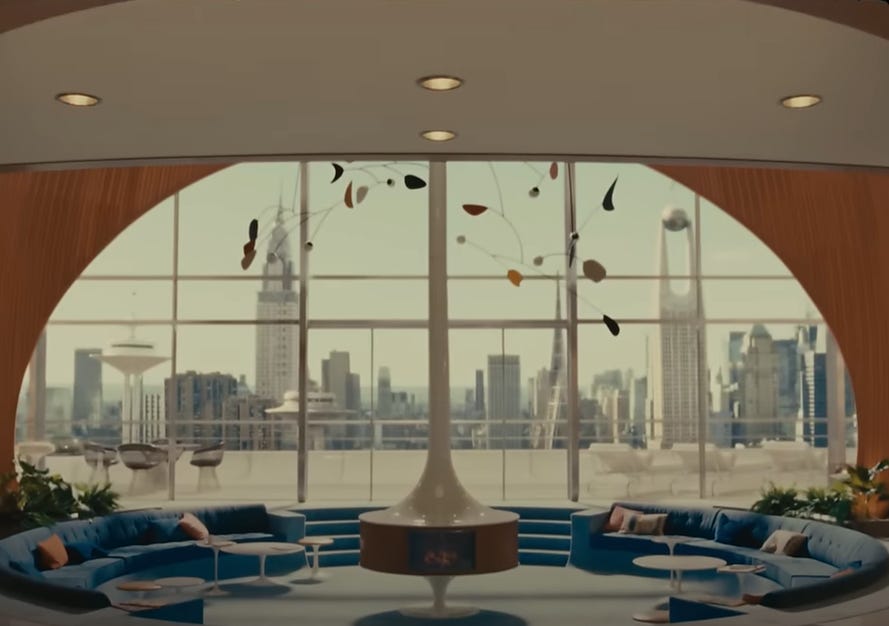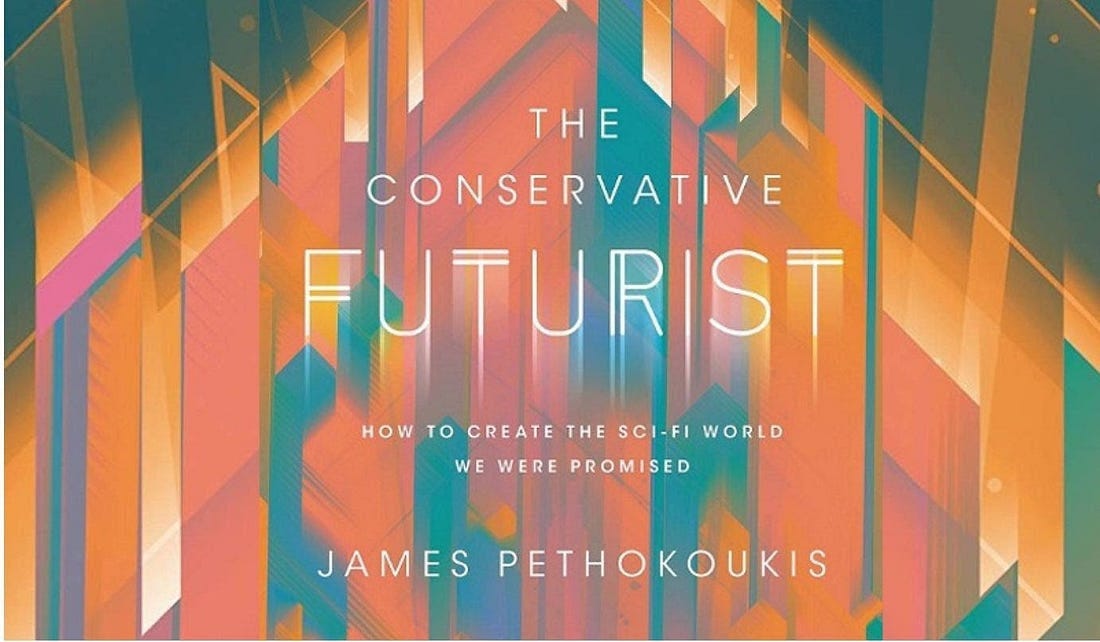My fellow pro-growth/progress/abundance Up Wingers,
I knew I had to write about The Fantastic Four: First Steps after watching the trailer earlier this year, its aesthetic dripping in the nostalgic optimism of Space Age Futurism.
And I did, noting that from the opening shot of the superhero team's sunken living room — decorated in sleek mid-century modern — within their skyscraper headquarters to their swept-wing rocket and an altered 1960s Manhattan skyline, we are shown a thoroughly Up Wing world.
The city shots showcase the exuberance of Googie architecture and its famous flourishes: stylized atoms, boomerangs, and parabolas. As with The Jetsons — the 1962 cartoon that's arguably the most influential futurist work of the twentieth century— Fantastic Four is infused with architectural movements that defined the era's vision of the future.
In recent interviews, director Matt Shakman and production designer Kasra Farahani tell how they brought this vision to life using practical sets and vintage lenses, aiming, according to Tatler Asia, to create something that “feels like it was made in 1965, the way Stanley Kubrick would have made it.”
To that end, Farahani drew inspiration from architects Eero Saarinen and Oscar Niemeyer, whose sweeping curves and space-age forms shaped the look of the Baxter Building, Reed Richards’ lab, and even the nursery. As he told Variety, about two-thirds of the film’s Times Square set replicates the real 1960s cityscape, while the remaining third features a retro-futuristic layer — including a monorail, neon signage, and “bubble cars” zipping between vintage Checker cabs. Reed’s lab includes color-coded zones for prototyping, contemplation, and mission control, a layout that channels Kubrick’s clean, modular sci-fi interiors.
Love it.
Yet after finally watching The Fantastic Four last weekend, I now realize the film’s design is hardly the most Up Wing thing about it. This all-time great Marvel movie reboots more than just a superhero franchise. It suggests a future-optimistic, techno-solutionist worldview that America has long neglected, both in its politics and culture. Maybe the multiversal Earth-828 isn’t a world headed toward a utopia, but it is certainly one without concerns about climate change, overpopulation, and deep poverty.
And when HUGE threats do pop up, the superpowered science heroes will think of a fix.
SPOILERS!
In a key plot turn, Galactus — the planet‑devouring cosmic entity — demands a harsh condition: If superpowered husband-and-wife Reed and Sue surrender their unborn son, he will spare Earth. They refuse, with Sue telling an anxious public, “I will not sacrifice my child for this world. But I will not sacrifice this world for my child.”
Rather than yield to the exchange, the team innovates a solution to their problem, one that requires as much brainpower as superpower. It’s time to build, with only fleeting public skepticism. Not only is this a world under threat, it’s one where the Fantastic Four have already demonstrated their ability to solve big problems with technology. Indeed, they’ve been so successful that their Future Foundation seems to operate as a pro-progress alternative to the United Nations. Perhaps that organization is why this retro-futuristic Earth-828 didn’t have a Vietnam War.
Or maybe in a world with so much progress and promise, people would rather build than fight. I would also guess that this version of America would have seemed even more dominant than it did in the post-Cold War 1990s here in our reality (which Marvel designates as Earth-1218, by the way).
That said, one could ding the film for not exploring the downsides to a world that’s seemingly subservient, although willingly, to a small group of superheroes and their global organization. Despite the existential threat from Galactus, there’s minimal to zero role for the US government or that of any other country. Over at The Bulwark, film critic Sonny Bunch highlights the film’s disinterest in the possible downsides of this techno-wonderland:
Consider, for instance, the look of worry that the rest of the team shares when Reed reveals he has unleashed a roving force of drone police to automatically stop all crime in New York City. When added to the idea that the world’s nations would simply disband their armies because Richards’s magical technologies are too good to pass up — and maybe they are; this is a guy who casually solves the problems of faster-than-light travel and teleportation of living matter offscreen — you get an inkling of, well, authoritarian megalomania perpetrated by a guy who thinks he knows what’s best for everyone given that he knows everything already. And that sort of ego-driven authoritarianism creates a solid conflict with the people of Earth. Here are folks who have given up so much autonomy to partake in a glorious future, and when the Fantastic Four is asked to make a single sacrifice for the greater good, albeit a large one … they refuse. And while the people of Earth do meekly protest what they see as the selfishness of Reed and Sue in the film, it is brief and treated as little more than a tantrum by scared folks. … These are conflicting ideals that often surface in the books on which the series is based, but they have no place here.
Maybe these darker themes will be explored in a sequel. But if you’re currently looking for an exploration of such ideas, I would suggest the Planetary comic book series by writer Warren Ellis and artist John Cassaday, published by the Wildstorm imprint of DC Comics. Key characters include a mirror-universe version of the Fantastic Four called simply The Four. They function not as humanity's protectors but as its gatekeepers, systematically throttling technological progress while accumulating power for themselves.
Of course, in our world, that role was performed by the Down Wing environmental movement.
On sale everywhere: The Conservative Futurist: How To Create the Sci-Fi World We Were Promised by James Pethokoukis
Micro Reads
▶ Economics
The Depopulation Bomb - WSJ
AI Could Solve the US Fiscal Problem - Apollo Academy
Falling U.S. Birth Rates Won't Lead to Population Collapse - RealClearScience
Strategic Avoidance and the Welfare Impacts of U.S. Solar Panel Tariffs - Gerarden et al.
▶ Business
Google’s AI fight is moving to new ground - FT Opinion
▶ Policy/Politics
Crypto’s Man in the White House - NYT Opinion
▶ AI/Digital
Consumer Law for AI Agents - Arxiv
▶ Biotech/Health
Beyond Wellness - Wired
We May Be on the Cusp of Transformative Alzheimer's Progress - RealClearScience
▶ Clean Energy/Climate
Climate Tech Companies Are All Data Center Companies Now - Heatmap News
The Texas nuclear energy era is about to begin - The Dallas Morning News
China reins in the spiralling construction costs of nuclear power — what can other countries learn? - Nature
How big tech plans to feed AI’s voracious appetite for power - The Economist
▶ Robotics/Drones/AVs
▶ Space/Transportation
▶ Up Wing/Down Wing
‘1984’ Hasn’t Changed, but America Has - NYT Opinion
Thinking Is Becoming a Luxury Good - NYT Opinion
Addiction Fiction: Dopamine Is Not Why Kids Love TikTok - RealClearInvestigations
▶ Substacks/Newsletters
MAGA doesn't build anything - Noahpinion
Trump's America Winning the AI Race - AI Supremacy
China’s on a different AI path - Exponential View
Can Sidestepping NEPA "Unleash Innovation" at USDA? - The Ecomodernist
The Bitter Lesson versus The Garbage Can - One Useful Thing
Does the U.S. Actually Have the Will to Reindustrialize? - Core Memory








As an 85 yr old techno from the 40s, I'm leery of techno without socio or psycho.
Who's gonna fix algorithmized titillation addiction?